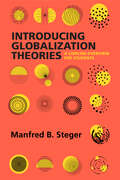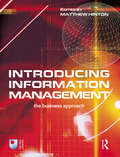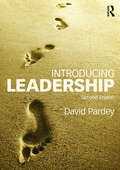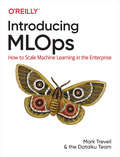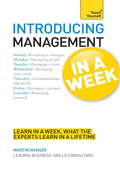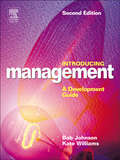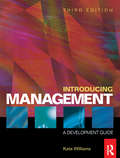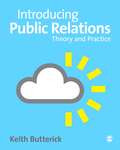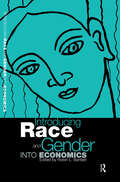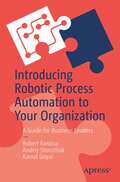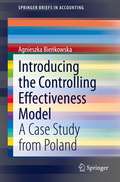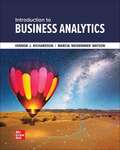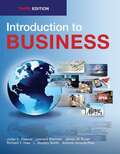- Table View
- List View
Introducing Globalization Theories: A Concise Overview for Students
by Prof. Manfred B. StegerSince the explosion of the buzzword "globalization" in academic and public discourse more than thirty years ago, theoretical explorations of worldwide interconnectivities and mobilities have proliferated across major academic disciplines. Introducing Globalization Theories is a short yet comprehensive primer to major globalization theories from the 1990s to the present. This accessible volume explains how globalization frameworks have been assembled by influential thinkers who employ different modes of inquiry. Short summaries, illustrations, and a supplemental guide to further reading equip students with tools to assess the strengths and weaknesses of each theory. Intersecting with relevant contemporary themes such as inequality and ecology, the book also highlights and features postcolonial and Indigenous globalization theories that challenge Western-centric views and point to a more equitable world.
Introducing Information Management
by Matthew HintonThis book provides a clear and concise overview of Information Management covering the key aspects of infrastructure, design, information assets and managing information.* Part 1 explores the diversity and changing nature of managing the information management function.* Part 2 investigates the role of information as an organizational resource.* Part 3 focuses on managing organizational data and information.* Part 4 examines the role of information management in organizational strategy and change.
Introducing Intercultural Communication
by Shuang LiuBooks on intercultural communication are rarely written with an intercultural readership in mind. In contrast, this multinational team of authors has put together an introduction to communicating across cultures that uses examples and case studies from around the world. The book further covers essential new topics, including international conflict, social networking, migration, and the effects technology and mass media play in the globalization of communication. Written to be accessible for international students too, this text situates communication theory in a truly global perspective. Each chapter brings to life the links between theory and practice and between the global and the local, introducing key theories and their practical applications. Along the way, you will be supported with first-rate learning resources, including: • theory corners with concise, boxed-out digests of key theoretical concepts • case illustrations putting the main points of each chapter into context • learning objectives, discussion questions, key terms and further reading framing each chapter and stimulating further discussion • a companion website containing resources for instructors, including multiple choice questions, presentation slides, exercises and activities, and teaching notes. This book will not merely guide you to success in your studies, but will teach you to become a more critical consumer of information and understand the influence of your own culture on how you view yourself and others.
Introducing Islamic Banks into Conventional Banking Systems
by Juan SoléA report from the International Monetary Fund.
Introducing Just Sustainabilities: Policy, Planning, and Practice
by Julian AgyemanThis unique and insightful text offers an exploration of the origins and subsequent development of the concept of just sustainability.
Introducing Leadership
by David PardeyComprehensive and highly practical, Introducing Leadership introduces the principles and practice of leadership, from theory through to the development of the reader's own leadership ability. From the analysis of the different sources of leadership and management theory emerges a model that will provide the basis for the development of readers' own leadership skills and for the application of these through the rest of the book. Written by an experienced author in the field of management development, the book is split into three parts:Section one - the nature and role of leadershipSection two - leading othersSection three - leading innovation and changeThe learning development is clearly structured and this text also provides the underpinning knowledge requirements for Level 3 qualifications in leadership.
Introducing MLOps: How To Scale Machine Learning In The Enterprise
by Mark Treveil Nicolas Omont Clément Stenac Kenji Lefevre Du Phan Joachim Zentici Adrien Lavoillotte Makoto Miyazaki Lynn HeidmannMore than half of the analytics and machine learning (ML) models created by organizations today never make it into production. Some of the challenges and barriers to operationalization are technical, but others are organizational. Either way, the bottom line is that models not in production can't provide business impact.This book introduces the key concepts of MLOps to help data scientists and application engineers not only operationalize ML models to drive real business change but also maintain and improve those models over time. Through lessons based on numerous MLOps applications around the world, nine experts in machine learning provide insights into the five steps of the model life cycle--Build, Preproduction, Deployment, Monitoring, and Governance--uncovering how robust MLOps processes can be infused throughout.This book helps you:Fulfill data science value by reducing friction throughout ML pipelines and workflowsRefine ML models through retraining, periodic tuning, and complete remodeling to ensure long-term accuracyDesign the MLOps life cycle to minimize organizational risks with models that are unbiased, fair, and explainableOperationalize ML models for pipeline deployment and for external business systems that are more complex and less standardized
Introducing Management in a Week: Teach Yourself
by Martin ManserThe ability to make a successful transition into management who wants to advance their career.Written by Martin Manser, a leading trainer of managers and highly-respected author, this book quickly teaches you the insider secrets you need to know to in order to seamlessly move up the career ladder.The highly motivational 'in a week' structure of the book provides seven straightforward chapters explaining the key points, and at the end there are optional questions to ensure you have taken it all in. There are also cartoons and diagrams throughout, to help make this book a more enjoyable and effective learning experience.So what are you waiting for? Let this book put you on the fast track to success!
Introducing Management in a Week: Teach Yourself
by Martin ManserThe ability to make a successful transition into management who wants to advance their career.Written by Martin Manser, a leading trainer of managers and highly-respected author, this book quickly teaches you the insider secrets you need to know to in order to seamlessly move up the career ladder.The highly motivational 'in a week' structure of the book provides seven straightforward chapters explaining the key points, and at the end there are optional questions to ensure you have taken it all in. There are also cartoons and diagrams throughout, to help make this book a more enjoyable and effective learning experience.So what are you waiting for? Let this book put you on the fast track to success!
Introducing Management: A Development Guide
by Bob JohnsonA concise and easy-to-read summary of the principles and practice of management for team leaders and line managers. Introducing Management defines the scope of the management task and breaks it down to clarify and explain the full range of management responsibilities: Managing in Context - an introduction to the management role, setting it in the context of the whole organization and responsibilities for the new manager; Managing People - how to motivate people, lead and delegate and manage teams to improve performance and successfully manage change; Managing Activities - adding value to inputs to meet customer needs, how to plan and organise the workplace to make improvements; Managing Information - how to acquire accurate, timely and relevant information for the basis of quality management decisions; Managing Resources - a guide to all you need to know about financial information, budgeting and stock control. This is the standard classification of management responsibilities adopted by most competence-based frameworks.
Introducing Management: A Development Guide
by Kate WilliamsNow fully revised and in its third edition, this comprehensive best-selling text, Introducing Management: A Development Guide, explains the principles and practice of management and is ideal for both new and existing managers to assist them in their role. The text incorporates the latest innovations in management thinking and reflects the changes within the management standards. This is an essential resource for those undertaking qualifications at S/NVQ at Level 3.The learning development is clearly structured in each chapter to include:-Objectives, Insights, Case Studies, Examples, Review Your Learning, Back to Work, allowing the user to check their understanding and apply the concepts and principles to their own work situation.
Introducing Money (Economics as Social Theory #33)
by Mark PeacockThis book provides a theoretical and historical examination of the evolution of money. It is distinct from the majority of ‘economic’ approaches, for it does not see money as an outgrowth of market exchange via barter. Instead, the social, political, legal and religious origins of money are examined. The methodological and theoretical underpinning of the work is that the study of money be historically informed, and that there exists a ‘state theory of money’ that provides an alternative framework to the ‘orthodox’ view of money’s origins. The contexts for analysing the introduction of money at various historical junctures include ancient Greece, British colonial dependencies in the nineteenth and early twentieth century, and local communities which introduce ‘alternative’ currencies. The book argues that, although money is not primarily an ‘economic’ phenomenon (associated with market exchange), it has profound implications (amongst others, economic implications) for societies and habits of human thought and action.
Introducing New Coke
by Susan FournierOn April 23, 1985, the Coca-Cola Co. announced a decision that would rock the world. The old Coke formula would be taken off the market and replaced with a smoother, sweeter taste. The reaction of the American people was immediate and violent, causing three months of unrelenting protest against the loss of Coke. Was the marketing research at fault? The launch strategy? Or did Coke "just not get it"? This case explores marketing's most famous public disaster to reveal deep lessons about managing the brand. Includes color exhibits.
Introducing Property Valuation
by Michael BlackledgeThis new edition of bestselling textbook Introducing Property Valuation provides students with a comprehensive introduction to the concepts and methods of valuing real estate, helping them to progress successfully from basic principles to a more sophisticated understanding. Taking a practically oriented rather than purely theoretical approach, the textbook equips readers with the skills to undertake their own valuation calculations. Fully updated to reflect recent developments in regulation and practice, experienced tutor and valuer Michael Blackledge demonstrates how the principles can be applied in professional practice in line with the requirements and guidance provided by the International Valuation Standards Council and the Royal Institution of Chartered Surveyors. Online material accompanies the new edition with Q&As and pre-programmed excel spreadsheets enabling students to prepare their own calculations. The five traditional methods of valuation are outlined and the practical applications of the two main approaches, the comparison and investment methods, are fully explored. The use of discounted cash flow and quarterly in advance calculations, topics which are not always adequately covered elsewhere, are also explained. Accessibly written with a full range of worked examples, case studies, clear chapter summaries and extensive further reading suggestions, this book is essential for any student of real estate and its valuation.
Introducing Public Administration (9th Edition)
by Jay M. Shafritz E. W. Russell Albert C. Hyde Christopher BorickThis is the now the 9th edition of a text first published in 1997. There's only one audience for a book of this nature--practitioners, students and teachers of public administration. In the original preface to this book we explained that we sought to create a text that would bridge two worlds, a text that would be informal enough to be accessible to undergraduates yet comprehensive enough for graduate students.
Introducing Public Relations: Theory and Practice
by Keith ButterickIntroducing Public Relations is your guide to the basics of public relations: where it came from, what it means and what issues the industry faces today. It takes readers from the origins of PR all the way to the newest theoretical debates, explaining along the way the changes and development of the role of the PR practitioner. With interviews and ′day in the life′ examples from a wide range of professionals in the industry students will learn what PR practitioners do, what they think and how the industry really works. Putting the student first, this book: Gives a grounded, critical coverage of the history and theory of PR, so students understand not just the what but the how and why Covers all aspects of PR in practice, from in-house and consultancies to government, sport, NGO and corporate PR Packs each chapter with case studies, anecdotes from the field and career advice from expert PR professionals Helps easy revision with exercises, summaries and checklist. Highly accessible and engaging, there is no better headstart to understanding what PR is all about. It is the perfect text for any students encountering public relations theory and practice for the first time.
Introducing Race and Gender into Economics
by Robin L BartlettEconomics has tended to be a very male, middle class, white discipline. Introducing Race and Gender into Economics is a ground-breaking book which generates ideas for integrating race and gender issues into introductory eocnomics courses. Each section gives an overview of how to modify standard courses, including macroeconomics, methodology, microeconomics as well as race and gender-sensitive issues. This up-to-date work will be of increasing importance to all teachers of introductory economics.
Introducing Robotic Process Automation to Your Organization: A Guide for Business Leaders
by Robert Fantina Andriy Storozhuk Kamal GoyalFor your robotic process automation (RPA) program to be successful, you need to follow a general framework and governance model. This book covers, in detail, what they should look like and how to adapt them to your organization.Introducing Robotic Process Automation to Your Organization is structured to enable you, a novice to RPA, to successfully implement an RPA program at your company. RPA is rapidly growing in use, but is only starting to be taught at a university level. Many mid-level managers will be tasked with introducing an RPA program at their organizations as senior management learns of its efficacy, but will be unfamiliar with how to do so. This book provides you with the skills and information you need to make an informed decision. For decades, there has been much discussion about the fast pace of technology, the rapidly changing technology environment, and the need for companies to be on the cutting edge to remain competitive or even relevant. In this ever-changing environment, there is a need to know what can be done in terms of current processes, here and now, that will increase efficiency, benefit customers, and improve profitability. One option is RPA.This book includes information to assist you in getting the required buy-in and identifying the first few processes for automation. A structure for identifying opportunities on an ongoing basis is detailed, along with concepts that must be considered for solution design and deployment. Throughout the book there are several "pause and consider" statements to help you think about how principles pertain to your organization. Additionally, there are tips included that offer short, concrete suggestions on how to help implement the particular step being discussed.What You Will LearnKnow the benefits of robotic process automation (RPA)Understand the limitations of RPAAsk the right questions to determine whether a process is a good candidate for automationObtain buy-in from skeptics at the senior and middle manager levels, and from line workersBe familiar with the structure required for successWho This Book is ForMiddle managers who have either identified the need for robotic process automation (RPA) in their organization or have been directed by senior management to explore the possibility of introducing RPA to their organization; managers at all levels who hear about RPA, either through conferences, professional associations, or industry publications, and want to know more; students of business and technology who wish to broaden their understanding of important current trends.
Introducing iSnack 2.0: The New Vegemite
by Anat Keinan Francis Farrelly Michael BeverlandVegemite is an iconic Australian breakfast spread and is often seen as a quintessential Australian product. This case focuses on Kraft's decision to revitalize brand performance through the introduction of a brand extension. Drawing on extensive social media analysis of brand image, the brand team led by Simon Talbot identified a gap in the market for a line extension involving a blend of Vegemite and Kraft's other iconic brand, Philadelphia Cream Cheese. Following a high profile campaign involving a competition to name the new extension Talbot's team chose the name iSnack 2.0 for the new product. The case starts two days after the public unveiling of this name and subsequent nationwide backlash against it. Talbot needs to consider whether to continue with the brand name or change it in light of the public outcry.
Introducing the Controlling Effectiveness Model: A Case Study from Poland (SpringerBriefs in Accounting)
by Agnieszka BieńkowskaFocusing on the controlling management method, this book considers the conditions that must be met within a given organization in order for controlling to achieve the desired level of product quality, allowing it to enhance the performance of the organization as a whole. The book describes the influence of each identified group of conditions on the Controlling Effectiveness Model and includes empirical research, conducted at various organizations operating in Poland, that verifies its theoretical assumptions. In terms of analyzing the empirical data, description and statistical inference methods were used, such as students’ t-test scores for independent samples, non-parametric r-Pearson correlation and linear regression analysis. Additionally, the book includes moderators and mediators executed using Process Macro for SPSS by Hayes, and multigroup path analysis executed using SPSS AMOS.
Introducing the Euro as Legal Tender--Benefits and Costs of Eurorization for Cape Verde
by Patrick ImamA report from the International Monetary Fund.
Introduction (The Strategy Map as a Visual Representation of Organizational Strategy)
by Robert S. Kaplan David P. NortonAn organization's strategy describes how it intends to create value for its shareholders, customers, and citizens. If an organization's intangible assets represent more than 75% of its value, then its strategy formulation and execution need to explicitly address the mobilization and alignment of intangible assets. This chapter introduces the strategy map, derived from the four-perspective model of the Balanced Scorecard, as an indispensable visual tool for aligning intangible assets to strategy for sustainable value creation. Two case studies follow to demonstrate the use of strategy maps.
Introduction To Business Analytics
by Vernon J. Richardson Katie Terrell Marcia Weidenmier WatsonIntroduction to Business Analytics recognizes that students need to develop the skills to ask the right questions, learn to use common workplace tools (such as Excel®, Tableau®, and Power BI®) to examine and analyze data, and interpret results accurately and effectively to make business decisions. Richardson provides a framework for developing a business analytics mindset called the SOAR analytics model which is composed of four steps― Specify the question, Obtain the data, analyze the data, and report the results. This model is used throughout the text in conjunction with the various types of data analysis that analysts need to perform. The lab activities, which appear at the end of each chapter, follow this framework to reinforce the analytical process. A capstone in the final chapter provides three projects that apply the complete SOAR model.
Introduction To Business, Third Edition (pb-4c)
by Leonard Bierman Julian Gaspar James Kolari Richard Hise L. Murphy Smith Antonio Arreola-RisaINTRODUCTION TO BUSINESS, 3/e stands apart from other entries in the market for its ability to make the fundamentals of business understandable, functional, and relevant to students with little or no business background. The authors believe that the key to unlocking Introduction to Business for novice students lies in the text’s unique, engaging pedagogy based on consistency, active learning, and current topics and examples. Introduction to Business, 3e, is the first cross-functionally authored text in the marketplace. Each of the six authors is a recognized authority in his field and brings personal expertise to the course, while keeping the discussion focused and concise for introductory-level students. The text presents a balanced and consistent voice across each of the unique content areas, enabling students to quickly gain an understanding of business concepts, practices, and relationships without unnecessary or disjointed narrative.
Introduction To Econometrics (Brief Edition)
by James H. Stock Mark W. WatsonIn keeping with their successful introductory econometrics text, Stock and Watson motivate each methodological topic with a real-world policy application that uses data, so that readers apply the theory immediately. Introduction to Econometrics, Brief, is a streamlined version of their text, including the fundamental topics, an early review of statistics and probability, the core material of regression with cross-sectional data, and a capstone chapter on conducting empirical analysis. Introduction and Review: Economic Questions and Data; Review of Probability; Review of Statistics. Fundamentals of Regression Analysis: Linear Regression with One Regressor; Regression with a Single Regressor: Hypothesis Tests and Confidence Intervals in the Single-Regressor Model; Linear Regression with Multiple Regressors; Hypothesis Tests and Confidence Intervals in the Multiple Regressor Model; Nonlinear Regression Functions; Assessing Studies Based on Multiple Regression; Conducting a Regression Study Using Economic Data. MARKET: For all readers interested in econometrics.
